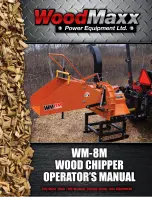
www.WoodMaxx.com
7
DRIVELINE SAFETY
DRIVELINE SAFETY
DRIVELINE SAFETY CHECKLIST
DRIVELINE SAFETY CHECKLIST
Agriculture and forestry are recognized as one of the most hazardous of occupations.
Today’s farmer spends long hours in close proximity to increasingly complex and
powerful machinery.
To avoid accidents, everyone from the component supplier and the company who
manufacturers and assembles the machinery, to the dealers and ultimately the
actual user, must keep safety in mind. The checklist below relates to the drive line of
agricultural implements, general safety literature, and the standards published by the
American Society of Agricultural Engineers.
Driveline Specifications
– The first step towards safe applications is to specify and
test the driveline so that it operates properly under expected field conditions.
✔
Specify and test the proper size joints and telescoping members based upon
the power required by the implement, speed of rotation, joints angles, shock
loads, and expected life.
✔
Test the hitch geometry to prevent the drive line from:
• Extending beyond the recommended maximum length.
• Bottoming out.
• Reaching a position that allows universal joints to lock.
• Exceeding the maximum allowable angle for constant velocity of
the universal joints.
Information concerning these parameters may be found in all driveline
manufacturer’s catalogs.
✔
Specify and test telescoping members to allow the lowest possible thrust loads,
considering the expected working conditions.
✔
Specify and test torque limiters to control excessive shock loads.
✔
Where necessary, specify and test overrunning clutches to prevent inertial loads
from overpowering the tractor.
Summary of Contents for WM-8M
Page 1: ......
Page 58: ...3 20...









































